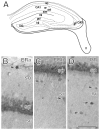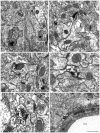Cellular and subcellular localization of estrogen and progestin receptor immunoreactivities in the mouse hippocampus
- PMID: 20506473
- PMCID: PMC2879091
- DOI: 10.1002/cne.22361
Cellular and subcellular localization of estrogen and progestin receptor immunoreactivities in the mouse hippocampus
Abstract
Estrogen receptor-alpha (ERalpha), estrogen receptor-beta (ERbeta), and progestin receptor (PR) immunoreactivities are localized to extranuclear sites in the rat hippocampal formation. Because rats and mice respond differently to estradiol treatment at a cellular level, the present study examined the distribution of ovarian hormone receptors in the dorsal hippocampal formation of mice. For this, antibodies to ERalpha, ERbeta, and PR were localized by light and electron immunomicroscopy in male and female mice across the estrous cycle. Light microscopic examination of the mouse hippocampal formation showed sparse nuclear ERalpha and PR immunoreactivity (-ir) most prominently in the CA1 region and diffuse ERbeta-ir primarily in the CA1 pyramidal cell layer as well as in a few interneurons. Ultrastructural analysis additionally revealed discrete extranuclear ERalpha-, ERbeta-, and PR-ir in neuronal and glial profiles throughout the hippocampal formation. Although extranuclear profiles were detected in all animal groups examined, the amount and types of profiles varied with sex and estrous cycle phase. ERalpha-ir was highest in diestrus females, particularly in dendritic spines, axons, and glia. Similarly, ERbeta-ir was highest in estrus and diestrus females, mainly in dendritic spines and glia. Conversely, PR-ir was highest during proestrus, mostly in axons. Except for very low levels of extranuclear ERbeta-ir in mossy fiber terminals in mice, the labeling patterns in the mice for all three antibodies were similar to the ultrastructural labeling found previously in rats, suggesting that regulation of these receptors is well conserved across the two species.
Figures





Similar articles
-
Ultrastructural localization of estrogen receptor beta immunoreactivity in the rat hippocampal formation.J Comp Neurol. 2005 Oct 17;491(2):81-95. doi: 10.1002/cne.20724. J Comp Neurol. 2005. PMID: 16127691
-
Ultrastructural localization of extranuclear progestin receptors in the rat hippocampal formation.J Comp Neurol. 2008 Nov 1;511(1):34-46. doi: 10.1002/cne.21826. J Comp Neurol. 2008. PMID: 18720413 Free PMC article.
-
Sex differences in hippocampal estradiol-induced N-methyl-D-aspartic acid binding and ultrastructural localization of estrogen receptor-alpha.Neuroendocrinology. 2005;81(6):391-9. doi: 10.1159/000089557. Epub 2005 Nov 4. Neuroendocrinology. 2005. PMID: 16276117
-
Tracking the estrogen receptor in neurons: implications for estrogen-induced synapse formation.Proc Natl Acad Sci U S A. 2001 Jun 19;98(13):7093-100. doi: 10.1073/pnas.121146898. Proc Natl Acad Sci U S A. 2001. PMID: 11416193 Free PMC article. Review.
-
Classical androgen receptors in non-classical sites in the brain.Horm Behav. 2008 May;53(5):753-64. doi: 10.1016/j.yhbeh.2008.02.015. Epub 2008 Mar 6. Horm Behav. 2008. PMID: 18402960 Free PMC article. Review.
Cited by
-
Cognitive effects of endocrine therapy for breast cancer: keep calm and carry on?Nat Rev Clin Oncol. 2015 Oct;12(10):597-606. doi: 10.1038/nrclinonc.2015.124. Epub 2015 Jul 21. Nat Rev Clin Oncol. 2015. PMID: 26196252 Review.
-
Epigenetic regulation of estrogen receptor α contributes to age-related differences in transcription across the hippocampal regions CA1 and CA3.Neurobiol Aging. 2017 Jan;49:79-85. doi: 10.1016/j.neurobiolaging.2016.09.013. Epub 2016 Sep 28. Neurobiol Aging. 2017. PMID: 27776265 Free PMC article.
-
Sex steroid hormones matter for learning and memory: estrogenic regulation of hippocampal function in male and female rodents.Learn Mem. 2015 Aug 18;22(9):472-93. doi: 10.1101/lm.037267.114. Print 2015 Sep. Learn Mem. 2015. PMID: 26286657 Free PMC article. Review.
-
Deciphering the Influence of Estradiol and Estrogen Receptors on Cognitive Function: A Bibliometric Analysis and Emerging Research Trends.Med Sci Monit. 2023 Jun 10;29:e939676. doi: 10.12659/MSM.939676. Med Sci Monit. 2023. PMID: 37300249 Free PMC article.
-
Metabolic Pattern of Brain Death-NMR-Based Metabolomics of Cerebrospinal Fluid.Int J Mol Sci. 2025 Mar 18;26(6):2719. doi: 10.3390/ijms26062719. Int J Mol Sci. 2025. PMID: 40141360 Free PMC article.
References
-
- Alves SE, McEwen BS, Hayashi S, Korach KS, Pfaff DW, Ogawa S. Estrogen-regulated progestin receptors are found in the midbrain raphe but not hippocampus of estrogen receptor alpha (ERα) gene-disrupted mice. J Comp Neurol. 2000;427:185–195. - PubMed
-
- Alves SE, Weiland NG, Hayashi S, McEwen BS. Immunocytochemical localization of nuclear estrogen receptors and progestin receptors within the rat dorsal raphe nucleus. J Comp Neurol. 1998;391:322–334. - PubMed
-
- Arias C, Zepeda A, Hernandez-Ortega K, Leal-Galicia P, Lojero C, Camacho-Arroyo I. Sex and estrous cycle-dependent differences in glial fibrillary acidic protein immunoreactivity in the adult rat hippocampus. Horm Behav. 2009;55:257–263. - PubMed
Publication types
MeSH terms
Substances
Grants and funding
LinkOut - more resources
Full Text Sources
Research Materials
Miscellaneous

